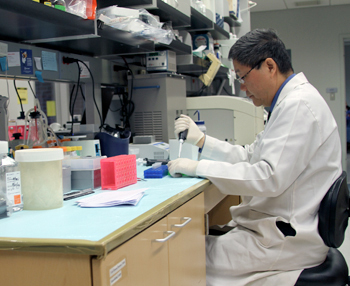Technology from Fish May Help Diagnose Cancer
Could a fish help doctors diagnose and treat cancer?
It may sound bizarre, but antibody technology developed from lamprey fish has shown promise as a cancer diagnostics tool, explains Li Mao, MD, associate dean for research and chair of the Department of Oncology and Diagnostic Sciences at the University of Maryland School of Dentistry.

Li Mao, MD, in his lab at the University of Maryland School of Dentistry.
Mao is the principal investigator on a project that was started more than a decade ago by the late Zeev Pancer, who was a researcher at the University of Maryland, Baltimore’s (UMB) Institute of Marine and Environmental Technology. Pancer discovered unique properties of the lamprey immune system that have implications for cancer therapy. Lampreys, jawless fish that measure 5 to 40 inches long, have existed for more than 300 million years. They do not create antibodies to fight disease; instead, their immune systems produce small molecules that circulate through the bloodstream and bind with invading cells. What makes these molecules unique is that they can recognize and bind to very specific sugar patterns that coat the outside of cells, Mao explains.
Pancer used this discovery to develop “Lambodies,” engineered molecules that are able to effectively bind to precise sugar molecule signatures. Lambodies can be designed to target the sugar molecule patterns of different types of tumor cells in the bloodstream, which could help medical professionals identify the presence of cancer, Mao explains. “Lambodies have potential to be used to detect the presence of cancer cells in body fluids before the physical tumor can be diagnosed,” Mao says. “Early diagnosis could help physicians set an individual up with the right therapeutic strategy.”
This technology has been taken one stop closer to becoming a reality. UMB recently granted a license agreement to AbBioSci, a Seattle-based technology company, to use the lambody technology to develop diagnostic tests. The technology also could be used to increase the therapeutic potential of cancer treatments by boosting the effectiveness of immune system-based therapies, Mao says.
“This is truly innovative,” he says. “This discovery comes from an area that has never been fully explored before. I’m excited for the potential this research has to improve cancer treatment and diagnosis.”


